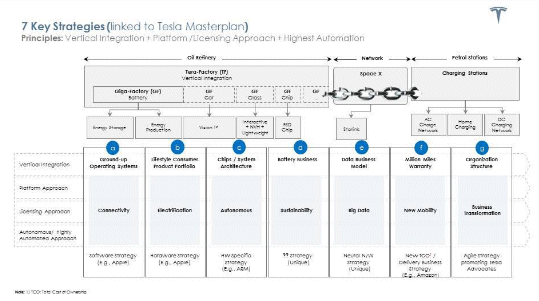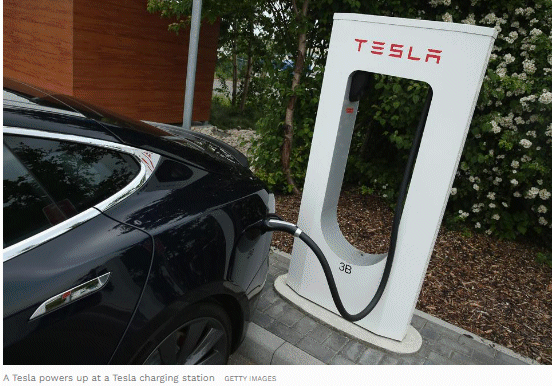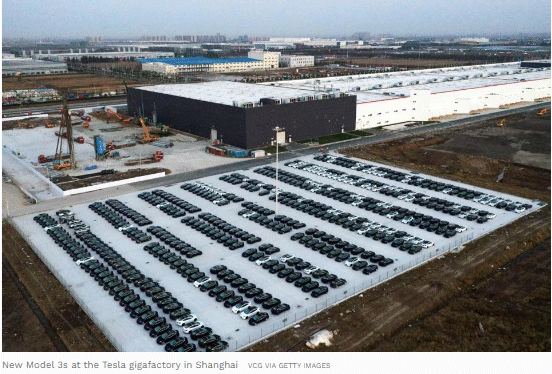Certainly not Elon Musk. He is storming his way up the Bloomberg Billionaire Index rankings, breathing down the neck of regulars like Jeff Bezos and Bill Gates. Tesla’s shares and stock value are climbing, its market value surging past the $100 billion mark. And, to add to his list of achievements this year, he’s become a father to X Æ A-Xii. I’ll confess though that I am much more excited about something else that he’s on track to produce – an entirely new industry based on networked energy.
Together with my team at Frost & Sullivan, we have been tracking Musk’s strategy closely over the years and here’s how we believe he’s going about creating it.
The Seven Point Strategy Behind Tesla’s Masterplan
The seven strategies at the core of Tesla’s masterplan—connectivity, electrification, autonomous, battery sustainability, data business model, new mobility and organizational structuring— would appear standard pre-requisites for any self-respecting automotive manufacturer. What’s different is how Musk has approached them as part of his larger global vision.

Let’s start with connectivity. Automakers typically have 3-4 domain architectures like infotainment, body, and advanced driving assistance systems (ADAS), each with their discrete operating systems (OS). The challenge here is that over-the-air (OTA) updates in one domain invariably have ripple effects on others, requiring 60-70% of engineering resource time to be spent on ensuring backward compatibility and integration.
Tesla differentiates itself with its proprietary ground OS, which enables it to be more agile, generate more innovative edge cases, distribute performance and power functionality based on new edge cases, and better protect its vehicles from cybersecurity threats because of fewer access gateways. In fact all the domains are built-up on that one single OS, reflective of a drastically different approach. This is something that only tech companies are well versed in doing. It represents a significant advantage which allows Tesla to have a 6-7 years tech advantage vs its nearest rival. Going forward, I see every car company trying to develop an OS platform in-house, just like VW is trying (and currently struggling) to do.
As the electric / autonomous driving vehicle (EV/ AD) revolution accelerates, Tesla is leading from the front in replacing horsepower with processing power. Much like Apple, Tesla’s chip has been designed in-house for a very specific use case, i.e., autonomous driving. This, along with ARM architecture, is fast-tracking Tesla’s autonomous agenda. In the process, Tesla is inventing a new currency that pivots around how much processing power can be utilized to support progressively superior energy efficiencies across core powertrain components.
For instance, the Model 3 has a 250KWH energy consumption which is important in a city environment because every mile saved from an energy density battery is critical currency. This gains even more importance because Musk is targeting urban robo-taxis as where 90% of his Model 3 vehicles will be leased and subsequently return to the Tesla charging network. What Tesla has essentially done is to use its cutting-edge customized chip / architecture system to dictate the narrative around EV/AD, encouraging future customers to evaluate vehicles based on a completely new set of currencies. Again, this is a core competency I expect every car company and major industrial manufacturer will need to develop in-house in the future, whether through insourcing or collaborations such as Daimler’s with NIVIDIA.

In terms of electrification, I think the fundamental point is that the Tesla vehicle is not just a car, it’s a lifestyle statement. It’s about creating a highly connected, electric car that supports superior performance and range attributes, and provides a top notch customer experience across all elements of a driver’s vehicle life onboard experience. This could in terms of the customized suspension settings for driving on bumpy roads or the completely redefined kid-friendly entertainment features which, from personal experience of having owned a Tesla for the last four years, is a boon for parents, especially on long car journeys.
Tesla is possibly the only company in the world which does not have model years. Instead, exponential changes in the software OTA enabled through a very seamless OS and backed by the localized focus of its gigafactories— for instance, the new gigafactory in Austin, Texas will concentrate on high demand cyber trucks and semis for the US market—allow the Tesla brand to be relevant to multiple customers, while being able to aggressively attack new segments, globally.
Meanwhile, Tesla is in ludicrous mode with its data business model. The business model works on the concept that any utility company or business entity (even other automakers) can use Tesla’s cutting-edge autobidder software to dispatch energy on the fly based on energy forecasting, dispatch optimization, and load forecasting. The autobidder software enables this by feeding not customer data but vehicle data in a highly anonymized way.
Battery sustainability is a crucial lynchpin in Tesla’s roadmap for the future. An update carried out earlier this year now gives third parties the ability to integrate charging stations into the Tesla map. In other words, battery pre-conditioning can now happen even if the Tesla customer chooses another charging station. While this is a convenience feature for customers, any third party charging station manufacturer that wants to be part of the Tesla network in the autobidder system will now have to pay a licensing fee.
The sixth strategic pillar revolves around new mobility which represents a highly disruptive approach to total cost of ownership (TCO). The main messaging here is that it would be financially insane to not own a Tesla. It is on this basis that I foresee the emergence of Tesla Mobility, part of a triumvirate featuring Tesla Energy and Tesla Motors.
I see parallels here with nemesis Jeff Bezos’s Amazon story. Today, Amazon is the world’s second most valued company because its cash cow came from an independent business i.e. the Amazon Cloud. Similarly, while we might continuously see a red line performance in the Profit & Loss sheet of Tesla Motors, the cash cow is not Space X or Tesla Motors, it is Tesla Energy which is growing at an explosive rate. This is the basis on which Musk has announced six gigafactories that will fuel Tesla Motors.

Another key aspect of Musk’s new mobility plans is the million miles warranty. In a stroke of marketing genius, the communication and assurance is of a vehicle practically lasting a million miles. The lubrication that goes behind it has also been developed in-house. A young company it might be but the vision of creating a Tesla-defined mobility environment come from the grail Musk set out to achieve 4-5 years ago: in essence, how to engineer a Tesla that would last a million miles.
The final cog is organizational structure and transformation. Eschewing the rigid hierarchies that lumber traditional automakers, Tesla has embraced a flexible and distributed organizational structure. Networks of teams operate in a highly people-centred culture, with an ecosystem designed to support creativity and efficiency.
Conclusion
At the heart, then, of Musk’s ambitious masterplan is the creation of a behemoth – Tesla Inc. – that conjoins Tesla Energy, Tesla Mobility and Tesla Motors to create a mega-entity that will drive exponential growth from sustainable energy, rather than sustainable transportation. It is a vision that will hook customers, fleets, and the biggest customer of them all – the city – into the Tesla ecosystem. Here, the car will no longer be the sole focal point, but only a part of a carefully calibrated strategy to build a completely new industry of networked energy.
This article was written with contributions from Benny Daniel, Business Unit Leader – Mobility, Aerospace & Defense (North America).
Article was originally published on Forbes.com



